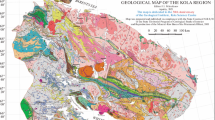Abstract
Detailed studies have shown that a change in the eudialyte occurrence forms (and the moment of its crystallization) is a new geochemical criterion for rare metal ore content in alkaline magmas (eudialyte ores). A new principle of the presence of ores in alkaline magmas has been formulated: a prerequisite for the formation of an ore deposit is early saturation of alkaline magmas with an ore mineral. If the ore component concentration is significantly lower than the cotectic (saturation) one, then melt saturation and crystallization of an ore mineral will take place at later stages of rock formation in a small volume of the interstitial melt, when the phenomena of convective–gravity differentiation and segregation of mineral phases in the form of ore deposits are hampered. This leads to dispersion of the ore components in the form of xenomorphic grains of accessory minerals. Rocks of the differentiated complex (lower zone of the Lovozero deposit) and rocks of the Khibiny massif contain xenomorphic eudialyte and are not promising for eudialyte ores. Eudialyte deposits are associated with the upper zone of the Lovozero intrusion where euhedral early eudialyte occurs. The initial magma is saturated with eudialyte after crystallization of about 85% of the intrusion. The proposed criterion is applicable to the largest alkaline massifs in the world. The Ilimaussaq massif (Greenland), the rocks of which contain early crystallized euhedral eudialyte, hosts a superlarge eudialyte ore deposit. Unlike the Khibiny massif and the Pilanesberg alkaline complex, the rocks of which contain late xenomorphic eudialyte, this massif has no deposits of this type.

Similar content being viewed by others
REFERENCES
U. Kramm and L. Kogarko, Lithos 32, 225–242 (1994).
V. I. Gerasimovskii, V. P. Volkov, L. N. Kogarko, A. I. Polyakov, T. V. Saprykina, and Yu. A. Balashov, Geology of the Lovozero Alkaline Massif (Nauka, Moscow, 1966) [in Russian].
L. N. Kogarko, C. T. Williams, and A. R. Wooley, Mineral. Petrol. 74, 1–24 (2002).
I. Parsons, Origin of Igneous Layering (Reidel, Dordrecht, 1987).
L. N. Kogarko, L. N. Lazutkina, and L. D. Krigman, The Conditions of Zircon Concentration in Magmatic Processes (Nauka, Moscow, 1988) [in Russian].
Funding
This work was supported by the Ministry of Science and Education of the Russian Federation, grant no. 075-15-2020-802.
Author information
Authors and Affiliations
Corresponding author
Additional information
Translated by N. Astafiev
Rights and permissions
About this article
Cite this article
Kogarko, L.N. Features of Eudialyte Ore Formation in High-Alkaline Magmas of the Lovozero Deposit (Kola Peninsula). Dokl. Earth Sc. 496, 112–114 (2021). https://doi.org/10.1134/S1028334X21020082
Received:
Revised:
Accepted:
Published:
Issue Date:
DOI: https://doi.org/10.1134/S1028334X21020082




